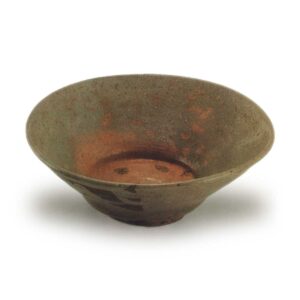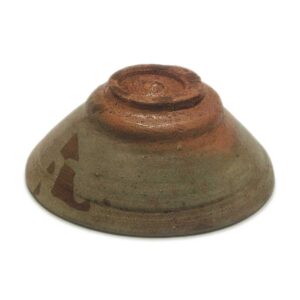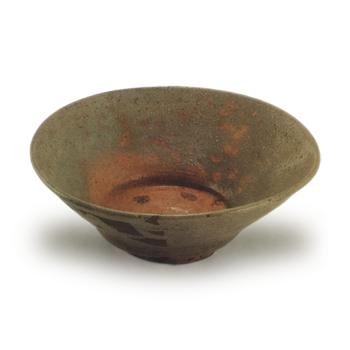

Height: 6.0cm
Diameter: 16.8cm
Height of foot ring: 6.2cm
Height of rim: 0.8-1.2cm
Soba is also written as 蕎麦. It is said that the character for soba was originally used to mean “well side”, and later came to be used to refer to buckwheat noodles. You can sometimes see old boxes marked “soba well” or “well soba”. However, there is a kind of convention in terms of shape, called sobagata.
In general, it is flat and large, with a slightly curved rim. The inside of the bowl is wide, with a flat bottom and a mirror-like finish, so the outside has a step at the bottom. In addition, the foot is low and large. The clay is slightly thick and sandy, and the glaze is similar to that of Hontoto-ya ware, as described in the book “Chaki Mekiri-shu” (“A Collection of Tea Vessel Connoisseurs”) as “made like the glaze of Jiyaku-to-ya ware”. Most of them are made with a blue glaze, but there are also yellow, red, and blue ones, which are similar to the Honte Toto-ya style. The name “soba-kasu” (soba flour) comes from the small speckles that appear on the glaze. The fact that there are eyes on the inside and on the foot ring is also a promise. In addition, there are small lines of nuta-hiki on the exterior, in the style of the Tōrikiya ware.
Natsuzuki is a particularly outstanding representative teacup among this Honte Soba ware, but what first catches the eye is the clear beauty of the calm blue and red of the nuta-hiki, and the strong yet subtle gradation of the Honte-yaku’s hem, which is without fault. The name “Natsuzuki” (summer moon) written in gold powder letters by Koetsu on the lid of the black lacquered box is probably a name given to the piece in reference to the reddish glow of the mirror in the center of the box, which is likened to the summer moon floating in the evening sky against the light blue background.
On the exterior, the two lines of the potter’s wheel marks stand out against the light blue background, adding a touch of tea-like charm, and the triangular fire marks that intermittently appear are a sight to behold. The stone next to it also adds to the charm of the tea bowl, but the strength of the sudden rise and bulge of the foot is such that it is hard to find a comparable bowl even among famous bowls, and it is the greatest charm of this tea bowl made in the summer moon. The reddish color of the rim and foot ring is magnificent, and the foot ring, which is made from thinly sliced bamboo, is also a highlight. The whorls inside the foot ring are in accordance with the rules of hontesoba, which require that the whorls be “narrowed like a wren’s tail”. The foot ring is also decorated with five trays, as is the style. The inside is a light yellow with red spots, and the mirror, which shows a bright scarlet color, is the highlight of this bowl. The five marks on the inside are also as promised, and in this case, they are an essential part of the bowl.
Box: black lacquer, lid: calligraphy by Hon’ami Koetsu in gold powder, character form “summer moon”
It is thought that this tea bowl was originally owned by Koetsu, but later passed into the possession of the Hirase family of Kyoto, and in recent years has been in the collection of a certain family in Osaka.



